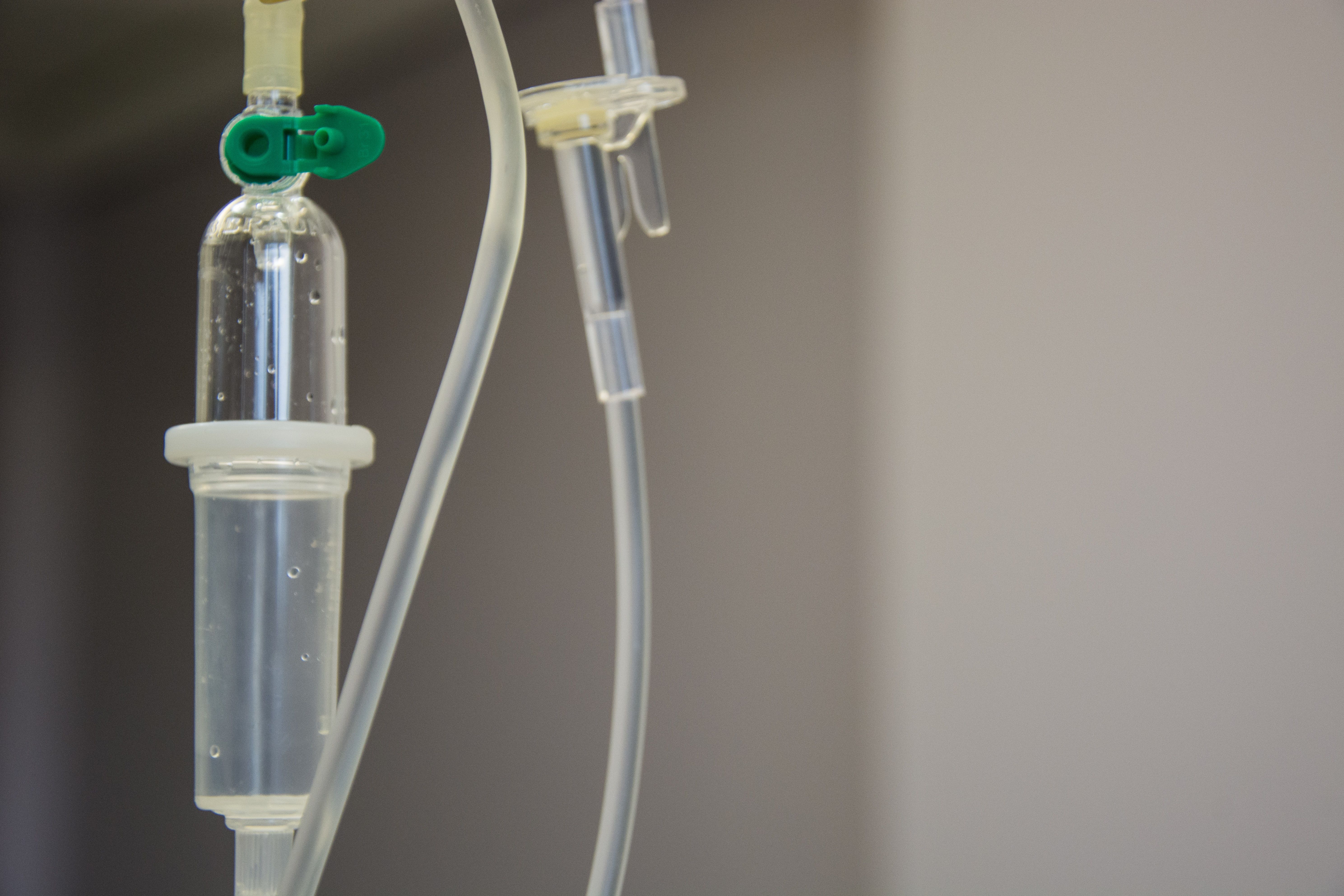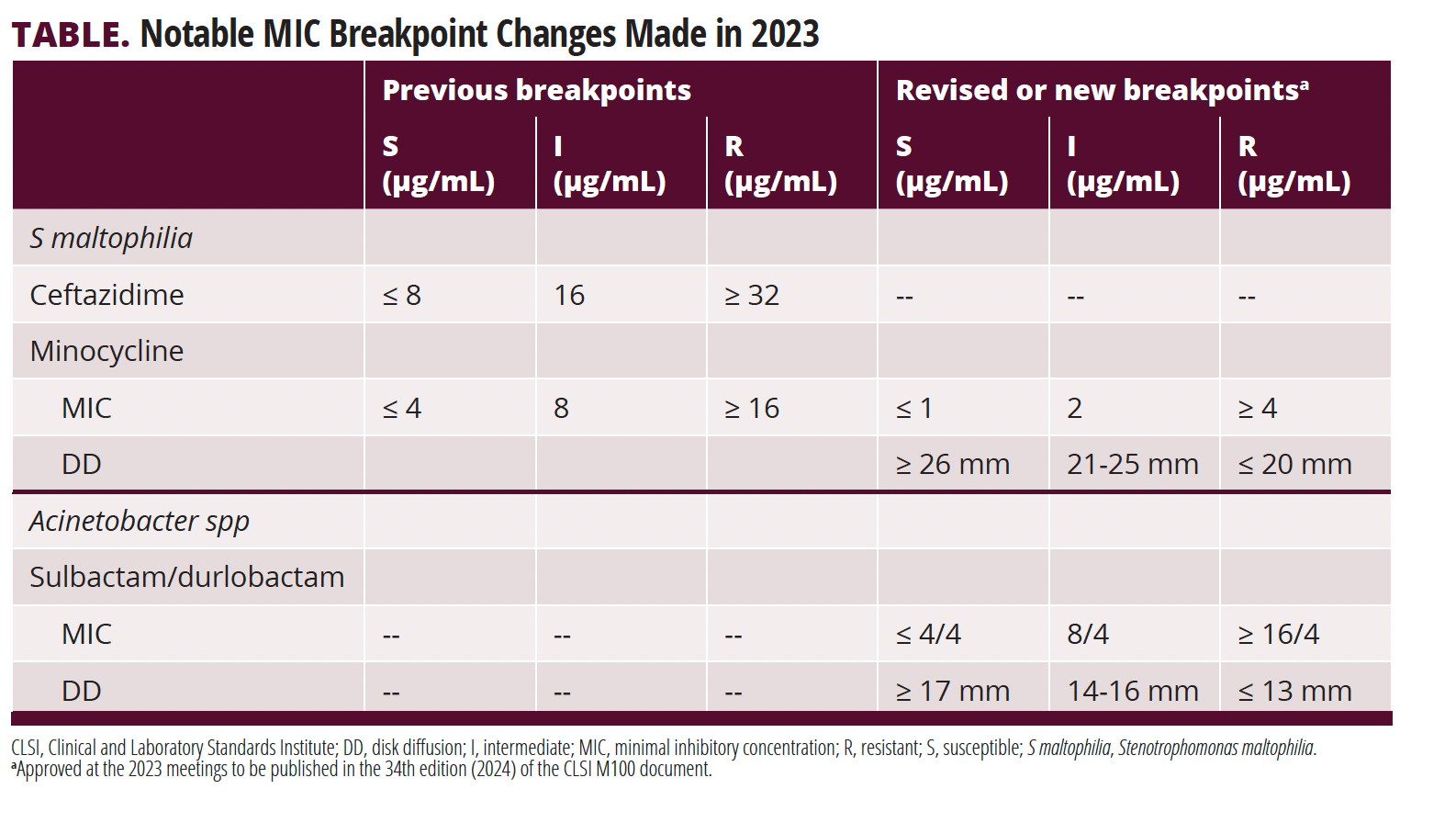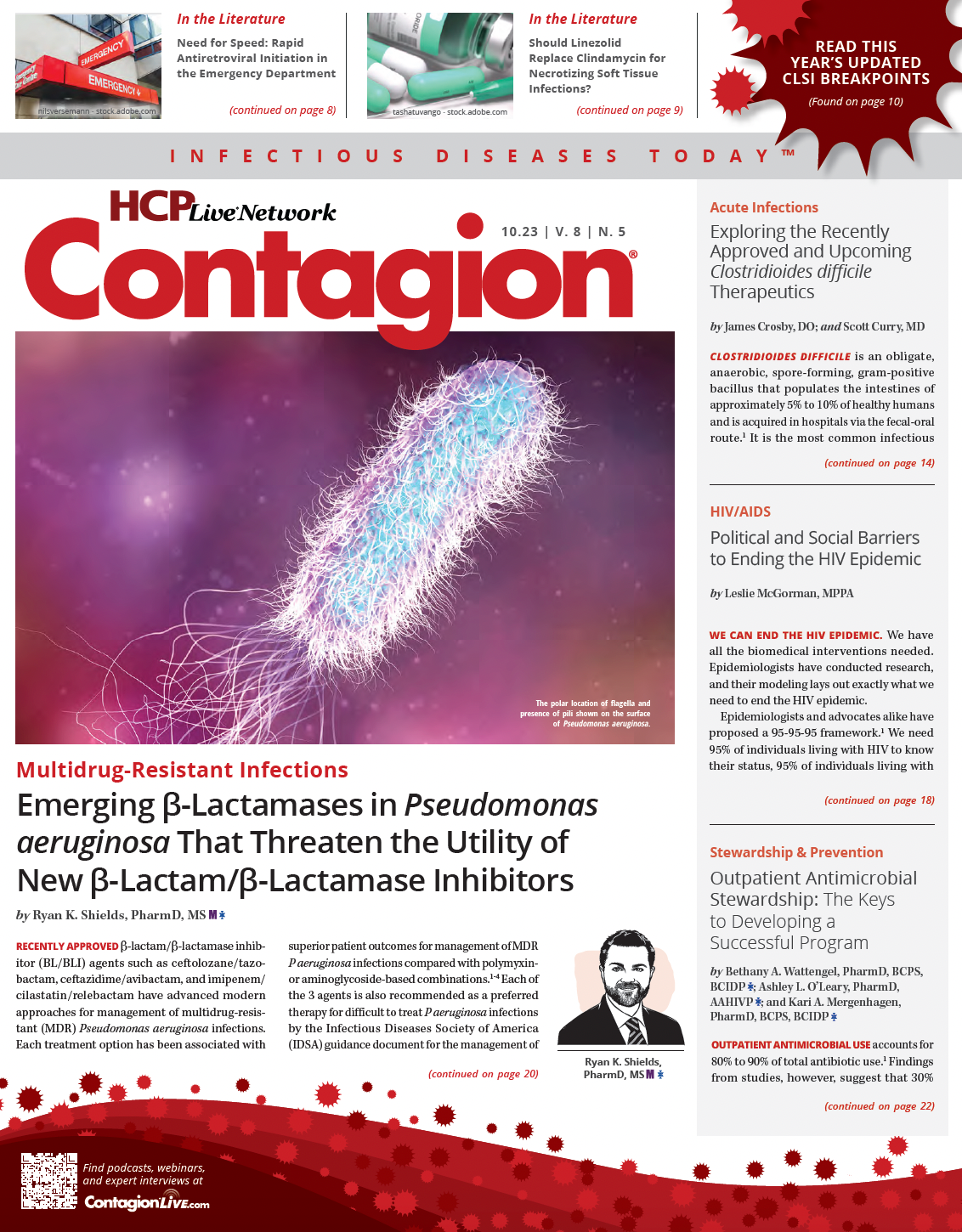The Clinical and Laboratory Standards Institute (CLSI) Subcommittee on Antimicrobial Susceptibility Testing held January and June meetings in 2023. Several breakpoint revisions and new breakpoints were introduced by ad hoc working groups (AHWGs) and approved by the subcommittee.
REVISED BREAKPOINTS
Ceftazidime, sulfamethoxazole/trimethoprim, and levofloxacin for Stenotrophomonas maltophilia
S maltophilia is a motile gram-negative bacillus with a small number of polar flagella that has undergone many naming and classification changes since its discovery.1 Clinically, it is most commonly seen as an opportunistic pathogen infecting individuals who present with chronic respiratory disease, have indwelling devices, have long-term hospitalization or intensive care unit stays, or are immunocompromised.1-4 An AHWG was formed in January 2022 to address the current S maltophilia breakpoints across several antimicrobials.
At the January 2023 meeting, ceftazidime breakpoints for S maltophilia were removed per the proposal of the AHWG. This recommendation came from a lack of data supporting the previous breakpoints and the inclusion of S maltophilia in the original clinical studies leading to initial US Food and Drug Administration (FDA) approval. The minimal inhibitory concentration (MIC) distribution, which used isolates from International Health Management Associates (IHMA; n = 5826) and JMI Laboratories (n = 2107), demonstrated a visual cutoff of more than 64 μg/mL, several dilutions higher than the breakpoint of 8 μg/mL or less that was previously in place (TABLE).5-7 Internal CLSI data, both contemporary and from 2003, showed poor agreement across replicates of the same isolates for agar dilution, broth microdilution (BMD), and disk diffusion (DD), with no DD breakpoints for ceftazidime against S maltophilia. The same poor susceptibility testing reproducibility was seen in 3 commercial BMD methods, with a wide major error rates range (11.1%-41.8%) when compared with the pharmacokinetic/pharmacodynamic (PK/PD) reference breakpoint.8 Additionally, L1 (class B3 metallo-β-lactamase) β-lactamases were detected in 77% of S maltophilia isolates (100 of 130) and L2 (class A cephalosporinase) β-lactamases were found in 89% of isolates (116 of 130) among the same collection.9 L1 β-lactamase hydrolyze carbapenems and other β-lactams; isolates with L2 demonstrate resistance to broad-spectrum cephalosporins but are inhibited by serine β-lactamase inhibitors.10 Thus, using ceftazidime in combination with avibactam would inhibit L2 producers but not L1 producers.10 The AHWG found no high-quality comparative studies of ceftazidime and other antimicrobials for S maltophilia, and sparse data have been published for clinical outcomes, including limited examples of successful treatment with ceftazidime monotherapy without removable foci of infection/surgical intervention. Because of these factors, as well as no FDA-approved indications for S maltophilia, the AHWG proposed the removal of ceftazidime breakpoints.
At the same January meeting, the minocycline breakpoints for S maltophilia were lowered. The MIC distribution created using isolates from IHMA (n = 942) and JMI (n = 1977) showed a visual cutoff of approximately 0.5 to 1 μg/mL, several dilutions lower than the previous susceptible breakpoint of 4 μg/mL or less.5,6 Using minocycline against S maltophilia resulted in high reproducibility using both standard and commercial BMD methods.8 Findings from 2 PK/PD studies were presented by the AHWG that demonstrated different probability of target attainment (PTA) for 1-log10 kill threshold. Fratoni et al used a neutropenic murine infection model and Monte Carlo simulation of intravenous (IV) minocycline 200 mg every 12 hours and demonstrated a 93% PTA at 0.5 μg/mL and a 0.1% PTA at 4 μg/mL with an area under the curve for free drug to the MIC (fAUC/MIC) of 23.6 μg/mL.11 Wei et al used Monte Carlo simulation of IV minocycline 100 mg every 12 hours and demonstrated a PTA of 94.4% or more at less than 4 μg/mL with a lower target fAUC/MIC of more than 8.75 μg/mL—the target of which was extrapolated from gram-positive bacteria.12 Findings from 4 retrospective observational clinical outcomes studies that were presented showed rates of minocycline failure were similar to those of sulfamethoxazole/trimethoprim (SMX/TMP), with noted limitations of primarily respiratory isolates and many polymicrobial samples.13-16 Jacobson et al found a significantly higher rate of minocycline failure against S maltophilia, for patients when their isolates had an MIC of 4 μg/mL compared with isolates having an MIC < 4 μg/mL.16 Based on a dose of 200 mg every 12 hours, the proposal to lower the MIC breakpoints was accepted in January 2023 followed by an amendment to the DD breakpoints in June 2023. At the June 2023 meeting, levofloxacin and SMX/TMP breakpoints against S maltophilia were also discussed, but comments were added that neither agent should be used as monotherapy.
Ceftriaxone against methicillin-susceptible Staphylococcus aureus
At the January 2023 meeting, the breakpoint for ceftriaxone against methicillin-susceptible S aureus (MSSA) was reassessed because of new dosing, PK/PD study findings, and clinical data as well as differences between CLSI guidelines and other regulatory organizations. CLSI, the FDA, and the European Committee on Antimicrobial Susceptibility Testing had moved away from breakpoints for ceftriaxone and most cephalosporins. Susceptibility has been inferred from various other β-lactams (eg, oxacillin); however, appropriate dosing information was unclear and determination of susceptibility varied depending on which guidelines were followed. The Breakpoint Working Group passed a motion to add a comment to the M100 document for ceftriaxone stating that susceptibility is based on a dosage of 2 g every 12 to 24 hours and “current data suggest that ceftriaxone may not be adequate for all MSSA infections. ID [infectious diseases] consult suggested.” The addition of this comment was also passed by the full AST subcommittee.
NEW BREAKPOINTS
Sulbactam/durlobactam for Acinetobacter spp
At the June 2023 meeting, several changes were approved for sulbactam/durlobactam (SUL/DUR) breakpoints, including accepting the proposed MIC breakpoints, DD breakpoint, and tier 3 placement in Table 1D in Performance Standards for Antimicrobial Susceptibility Testing. SUL/DUR is a β-lactam/β-lactamase inhibitor combination approved by the FDA in May 2023 for the treatment of adults with hospital-acquired bacterial pneumonia and ventilator-associated bacterial pneumonia caused by susceptible strains of Acinetobacter baumannii-calcoaceticus complex (ABC).17-19 Sulbactam is a β-lactam penicillin derivative and common β-lactamase inhibitor with targeted activity against Acinetobacter; however, resistance to this antibiotic is becoming increasingly more common. Durlobactam is a non–β-lactam diazabicyclooctane and potent inhibitor of class A, C, and D β-lactamases that restores antibacterial activity of sulbactam against resistant Acinetobacter strains.
What You Should Know
Ceftazidime breakpoints for Stenotrophomonas maltophilia were removed due to a lack of supporting data and its poor reproducibility in susceptibility testing.
The breakpoint for ceftriaxone against MSSA was reassessed, taking into account new dosing, PK/PD studies, and clinical data.
New breakpoints for sulbactam/durlobactam (SUL/DUR) were introduced for Acinetobacter spp, a combination approved for treating hospital-acquired bacterial pneumonia. The proposed MIC breakpoints were provided as susceptible, intermediate, and resistant, based on MIC values.
The proposed MIC breakpoints for Acinetobacter spp were susceptible (S; ≤ 4/4 μg/mL, ≥ 17 mm), intermediate (I; 8/4 μg/mL, 14-16 mm), and resistant (R; ≥ 16/4 μg/mL, ≤ 13 mm). Of note, the durlobactam is tested at a fixed concentration of 4 μg/mL. In a collection of 5032 global clinical isolates of Acinetobacter spp collected from 2016 to 2021, sulbactam alone had an MIC90 of 64 μg/mL whereas the SUL/DUR combination had an MIC90 of 2/4 μg/mL.20 Antimicrobial activity of SUL/DUR was maintained across individual Acinetobacter species, resistance phenotypes, and geographic regions. The proposed breakpoints aligned with the epidemiological cutoff value and included 98.1% of isolates.
Population PK models for SUL/DUR were developed using internal CLSI clinical data from 8 clinical trials. There was a high PTA for Acinetobacter spp following SUL/DUR exposure in plasma and epithelial lining fluid at the proposed MIC breakpoint, exceeding the PK/PD efficacy target of 1-log10 kill.
SUL/DUR also appeared to be well tolerated, with a significantly lower incidence of nephrotoxicity compared with colistin (P < .001) based on findings from the ATTACK trial (NCT03894046), a phase 3, multinational, randomized, active-controlled, noninferiority clinical trial.19 Patients (n = 181; n = 125 patients with carbapenem-resistant ABC) were randomly assigned 1:1 to receive either SUL/DUR (1 g/1 g over 3 hours every 6 hours) or colistin for 7 to 14 days, both in combination with imipenem/cilastatin as background therapy. Patients treated with SUL/DUR met criteria for noninferiority to colistin based on the primary end point of 28-day all-cause mortality.19
The AHWG suggested placement in Table 1D as tier 3 instead of tier 2 and including data on the reproducibility of MICs, particularly for the S and I breakpoints. After discussion of testing tiers, tier 3 placement was ultimately passed.
References
1.Brooke JS. Stenotrophomonas maltophilia: an emerging global opportunistic pathogen. Clin Microbiol Rev. 2012;25(1):2-41. doi:10.1128/CMR.00019-11
2.Calza L, Manfredi R, Chiodo F. Stenotrophomonas (Xanthomonas) maltophilia as an emerging opportunistic pathogen in association with HIV infection: a 10-year surveillance study. Infection. 2003;31(3):155-161. doi:10.1007/s15010-003-3113-6
3.Lai CH, Chi CY, Chen HP, et al. Clinical characteristics and prognostic factors of patients with Stenotrophomonas maltophilia bacteremia. J Microbiol Immunol Infect. 2004;37(6):350-358.
4.Metan G, Hayran M, Hascelik G, Uzun O. Which patient is a candidate for empirical therapy against Stenotrophomonas maltophilia bacteraemia? an analysis of associated risk factors in a tertiary care hospital. Scand J Infect Dis. 2006;38(6-7):527-531. doi:10.1080/00365540500452481
5.Your global antimicrobial partner. International Health Management Associates. Accessed August 3, 2023. https://www.ihma.com/
6.Advancing antimicrobial therapies worldwide through outstanding science. JMI Laboratories. Accessed August 3, 2023. https://www.jmilabs.com/
7.Clinical and Laboratory Standards Institute. Performance Standards for Antimicrobial Susceptibility Testing. 33rd ed. Clinical and Laboratory Standards Institute; 2023. CLSI supplement M100.
8.Khan A, Arias CA, Abbott A, Dien Bard J, Bhatti MM, Humphries RM. Evaluation of the Vitek 2, Phoenix, and MicroScan for antimicrobial susceptibility testing of Stenotrophomonas maltophilia. J Clin Microbiol. 2021;59(9):e0065421. doi:10.1128/JCM.00654-21
9.Mojica MF, Rutter JD, Taracila M, et al. Population structure, molecular epidemiology, and β-lactamase diversity among Stenotrophomonas maltophilia isolates in the United States. mBio. 2019;10(4):e00405-19. doi:10.1128/mBio.00405-19
10.Sader HS, Duncan LR, Arends SJR, Carvalhaes CG, Castanheira M. Antimicrobial activity of aztreonam-avibactam and comparator agents when tested against a large collection of contemporary Stenotrophomonas maltophilia isolates from medical centers worldwide. Antimicrob Agents Chemother. 2020;64(11):e01433-20. doi:10.1128/AAC.01433-20
11.Fratoni AJ, Nicolau DP, Kuti JL. Minocycline pharmacodynamics against Stenotrophomonas maltophilia in the neutropenic murine infection model: implications for susceptibility breakpoints. J Antimicrob Chemother. 2022;77(4):1052-1060. doi:10.1093/jac/dkac018
12.Wei C, Ni W, Cai X, Cui J. A Monte Carlo pharmacokinetic/pharmacodynamic simulation to evaluate the efficacy of minocycline, tigecycline, moxifloxacin, and levofloxacin in the treatment of hospital-acquired pneumonia caused by Stenotrophomonas maltophilia. Infect Dis (Lond). 2015;47(12):846-851. doi:10.3109/23744235.2015.1064542
13.Junco SJ, Bowman MC, Turner RB. Clinical outcomes of Stenotrophomonas maltophilia infection treated with trimethoprim/sulfamethoxazole, minocycline, or fluoroquinolone monotherapy. Int J Antimicrob Agents. 2021;58(2):106367. doi:10.1016/j.ijantimicag.2021.106367
14.Latzer IT, Nahum E, Cavari Y, et al. Treatment outcomes of Stenotrophomonas maltophilia bacteremia in critically ill children: a multicenter experience. Pediatr Crit Care Med. 2019;20(5):e231-e239. doi:10.1097/PCC.0000000000001919
15.Hand E, Davis H, Kim T, Duhon B. Monotherapy with minocycline or trimethoprim/sulfamethoxazole for treatment of Stenotrophomonas maltophilia infections. J Antimicrob Chemother. 2016;71(4):1071-1075. doi:10.1093/jac/dkv456
16.Jacobson S, Junco Noa L, Wallace MR, Bowman MC. Clinical outcomes using minocycline for Stenotrophomonas maltophilia infections. J Antimicrob Chemother. 2016;71(12):3620. doi:10.1093/jac/dkw327
17.Xacduro. Prescribing information. Entasis; 2023. Accessed August 10, 2023. https://xacduro-assets.s3.amazonaws.com/prescribing-information.pdf
18.FDA approves new treatment for pneumonia caused by certain difficult-to-treat bacteria. News release. May 23, 2023. Updated May 24, 2023. Accessed August 10, 2023. https://www.fda.gov/news-events/press-announcements/fda-approves-new-treatment-pneumonia-caused-certain-difficult-treat-bacteria
19.Kaye KS, Shorr AF, Wunderink RG, et al. Efficacy and safety of sulbactam-durlobactam versus colistin for the treatment of patients with serious infections caused by Acinetobacter baumannii-calcoaceticus complex: a multicentre, randomised, active-controlled, phase 3, non-inferiority clinical trial (ATTACK). Lancet Infect Dis. 2023;23(9):1072-1084. doi:10.1016/S1473-3099(23)00184-6
20.Karlowsky JA, Hackel MA, McLeod SM, Miller AA. In vitro activity of sulbactam-durlobactam against global isolates of Acinetobacter baumannii-calcoaceticus complex collected from 2016 to 2021. Antimicrob Agents Chemother. 2022;66(9):e0078122. doi:10.1128/aac.00781-22



